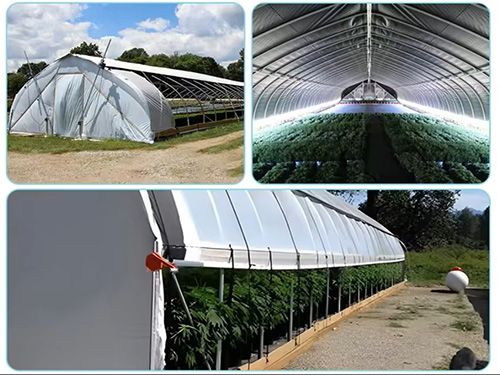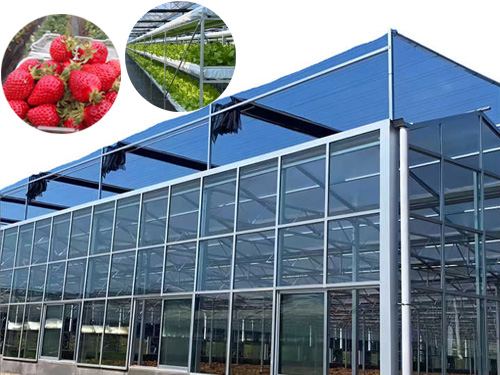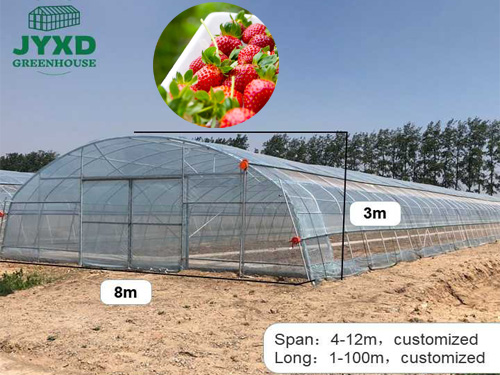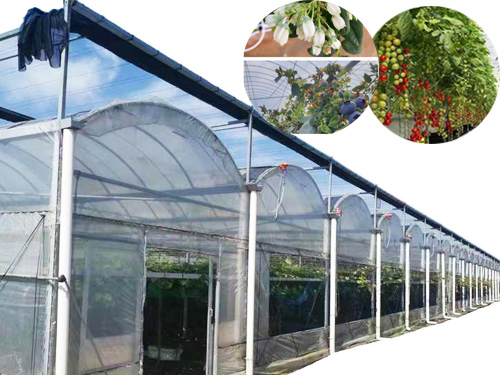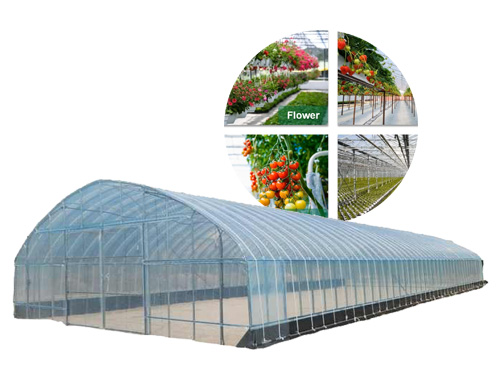NEWS DETAILS
NEWS INFORMATION
Greenhouse Humidity Management: Fogging Systems vs. Natural Ventilation Efficiency
AUTHOR:jyxd-greenhouse DATE:2025-04-16 00:14:32 HITS:104
Humidity management is a critical aspect of greenhouse operations, as improper levels can lead to plant stress, disease outbreaks, and reduced yields. Two common methods for controlling humidity are fogging systems and natural ventilation. Each approach has its advantages and tradeoffs, depending on the greenhouse’s size, location, and crop requirements. This article explores the efficiency of fogging systems and natural ventilation, helping growers choose the best strategy for their greenhouse humidity management needs.
Why Humidity Management Matters in Greenhouses
Maintaining optimal humidity levels is essential for healthy plant growth:
· Optimal Range: Most plants thrive at 50-70% relative humidity.
· Prevents Disease: High humidity encourages fungal diseases like powdery mildew and botrytis.
· Enhances Photosynthesis: Balanced humidity ensures efficient transpiration and nutrient uptake.
· Reduces Stress: Prevents wilting and dehydration in low-humidity conditions.
1. Fogging Systems: Precision Humidity Control
Fogging systems are an advanced method for increasing humidity in greenhouses. They work by releasing fine water droplets into the air, which evaporate quickly to raise humidity levels.
How Fogging Systems Work:
· High-Pressure Pumps: Generate fine mist through specialized nozzles.
· Even Distribution: Ensure uniform humidity levels across the greenhouse.
· Automated Control: Can be integrated with sensors and timers for precise humidity management.
Benefits of Fogging Systems:
· Precision: Provides accurate humidity control, especially in dry climates.
· Cooling Effect: Evaporative cooling reduces temperatures during hot weather.
· Scalability: Suitable for both small and large greenhouses.
· Water Efficiency: Uses minimal water compared to traditional irrigation.
Challenges:
· Initial Cost: High upfront investment in equipment and installation.
· Maintenance: Requires regular cleaning and maintenance to prevent nozzle clogging.
· Energy Use: Consumes electricity to operate high-pressure pumps.
2. Natural Ventilation: Eco-Friendly Humidity Control
Natural ventilation relies on passive airflow to regulate humidity levels. It involves strategically placed vents, windows, and openings to allow moist air to escape and drier air to enter.
How Natural Ventilation Works:
· Roof Vents: Allow warm, humid air to rise and escape.
· Side Vents: Draw in cooler, drier air from outside.
· Wind-Driven Airflow: Utilizes natural wind patterns to enhance ventilation.
Benefits of Natural Ventilation:
· Cost-Effective: Low initial and operational costs.
· Energy Efficiency: No electricity required, reducing environmental impact.
· Simplicity: Easy to design and maintain.
· Climate Adaptability: Works well in regions with consistent wind patterns.
Challenges:
· Limited Control: Less precise than fogging systems, especially in stagnant air conditions.
· Weather Dependency: Effectiveness varies with external temperature and wind conditions.
· Space Requirements: Requires adequate space for vents and airflow.
3. Comparing Fogging Systems and Natural Ventilation
Choosing between fogging systems and natural ventilation depends on factors like climate, greenhouse size, and crop needs. Here’s a comparison to help you decide:
Humidity Control:
· Fogging Systems: Provide precise, adjustable humidity levels.
· Natural Ventilation: Offers passive humidity regulation with less precision.
Energy Use:
· Fogging Systems: Consume electricity for pumps and automation.
· Natural Ventilation: Requires no energy, making it more sustainable.
Cost:
· Fogging Systems: Higher upfront and maintenance costs.
· Natural Ventilation: Lower initial and operational costs.
Scalability:
· Fogging Systems: Suitable for all greenhouse sizes.
· Natural Ventilation: More effective in smaller or well-designed greenhouses.
4. Combining Fogging Systems and Natural Ventilation
For many growers, a hybrid approach offers the best of both worlds:
· Fogging Systems: Increase humidity during dry periods or in specific crop zones.
· Natural Ventilation: Reduce humidity during wet or stagnant conditions.
Synergistic Benefits:
· Enhanced Control: Achieve precise humidity levels while minimizing energy use.
· Cost Efficiency: Reduce reliance on fogging systems, lowering operational expenses.
· Adaptability: Respond to changing weather conditions effectively.
5. Best Practices for Greenhouse Humidity Management
To maximize the effectiveness of humidity control methods, follow these best practices:
Monitor Humidity Levels:
· Use Hygrometers: Install sensors to track humidity levels in different areas of the greenhouse.
· Automated Systems: Integrate sensors with climate control systems for real-time adjustments.
Optimize Ventilation:
· Strategic Vent Placement: Position vents for maximum airflow efficiency.
· Automated Vents: Use motorized vents that open and close based on humidity levels.
Maintain Equipment:
· Clean Nozzles: Regularly inspect and clean fogging system nozzles to prevent clogging.
· Inspect Vents: Ensure vents are functioning properly and free of obstructions.
Adapt to Crop Needs:
· Tailor Strategies: Adjust humidity control methods based on specific crop requirements.
· Seasonal Adjustments: Modify approaches to account for seasonal changes in temperature and humidity.
6. Benefits of Effective Humidity Management
Implementing fogging systems and natural ventilation offers numerous advantages:
· Healthier Plants: Maintains optimal growing conditions, reducing stress and disease.
· Higher Yields: Ensures efficient photosynthesis and nutrient uptake for better crop production.
· Resource Efficiency: Reduces water and energy waste by managing humidity effectively.
· Cost Savings: Minimizes losses from disease and equipment maintenance.
Conclusion
Greenhouse humidity management is essential for successful cultivation, and fogging systems and natural ventilation are powerful tools for achieving it. By understanding the strengths and limitations of each method, growers can choose the best strategy—or a hybrid approach—to maintain optimal humidity levels. Whether you’re a small-scale grower or a commercial operator, these strategies will help you create a healthy and productive greenhouse environment.
For more expert tips and high-quality greenhouse solutions, visit our website and take your farming practices to the next level. Let’s grow smarter and cultivate a greener future together!
![]()
Meta Description: Discover how fogging systems and natural ventilation can optimize humidity control in greenhouses. Learn strategies for maintaining healthy plant growth and efficient resource use.
Hebei Juyou Xinda Greenhouse Facilities Co.,Ltd.
Copyright © 2024-2025 https://www.jyxd-greenhouse.com. All Rights Reserved Hebei Juyou Xinda Greenhouse Facilities Co.,Ltd.Copyright





 Current Location:
Current Location:


